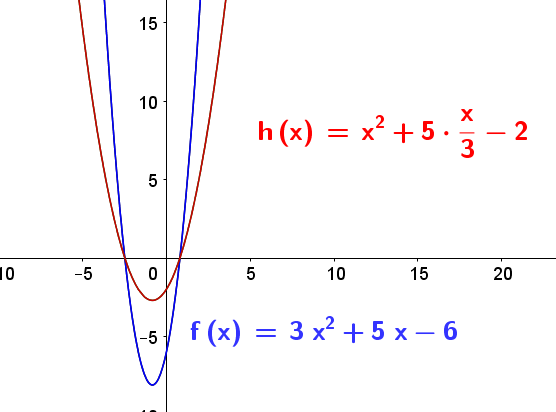Factoring with the Quadratic Formula
When one uses the quadratic formula to solve an equation of the form $ax+bx+c=0$, one gets a pair of $x$ values which may, or not, be identical. If and only if the leading coefficient a was a $1$, then the equation will have two factors, $(x-x_{1})\cdot(x-x_{2})$. If however, the coefficient a was a value other than $1$, then the factors will be $a(x-x_{1})\cdot(x-x_{2})$. That is, you can use the quadratic formula to factor a quadratic equation - it works with complex numbers too. But, the quadratic formula completes the square “inside the parenthesis” and you must reapply the leading factor $a$, to get the original equation. See the figure.
Example:
Factor the equation $f(x)=3x^{2}+5x-6$.
Answer: First, we write the homogeneous equation: $3x^{2}+5x-6=0$. Be aware that the homogeneous equation has the same solution set as the function, but the equation is not the same! The homogeneous equation is a pair of parallel lines combined into one equation. After using the quadratic formula, we get: $$x_{1}=\frac{-\sqrt{97}-5}{6}\qquad x_{2}=\frac{\sqrt{97}-5}{6}$$ Therefore, factors of the homogeneous equation are $$\left(x-\frac{-\sqrt{97}-5}{6}\right)\cdot\left(x-\frac{\sqrt{97}-5}{6}\right)$$ But, if we multiply these out and set them equal to $y$, we get $y=x^{2}+5x/3-2$. This is not the same function as $y=3x^{2}+5x-6$. The correct factors and original function would have been $$y=3\cdot\left(x-\frac{-\sqrt{97}-5}{6}\right)\cdot\left(x-\frac{\sqrt{97}-5}{6}\right)$$
Answer: First, we write the homogeneous equation: $3x^{2}+5x-6=0$. Be aware that the homogeneous equation has the same solution set as the function, but the equation is not the same! The homogeneous equation is a pair of parallel lines combined into one equation. After using the quadratic formula, we get: $$x_{1}=\frac{-\sqrt{97}-5}{6}\qquad x_{2}=\frac{\sqrt{97}-5}{6}$$ Therefore, factors of the homogeneous equation are $$\left(x-\frac{-\sqrt{97}-5}{6}\right)\cdot\left(x-\frac{\sqrt{97}-5}{6}\right)$$ But, if we multiply these out and set them equal to $y$, we get $y=x^{2}+5x/3-2$. This is not the same function as $y=3x^{2}+5x-6$. The correct factors and original function would have been $$y=3\cdot\left(x-\frac{-\sqrt{97}-5}{6}\right)\cdot\left(x-\frac{\sqrt{97}-5}{6}\right)$$
